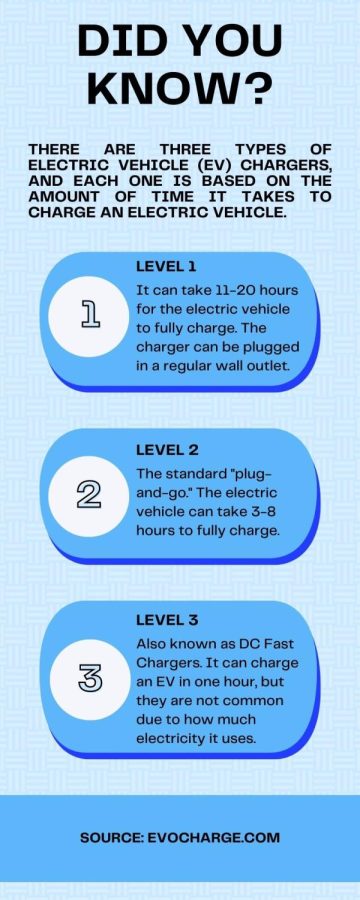No plans in place for additional electric vehicle chargers
December 8, 2022
Colleges and universities around Southern California have more electric vehicle chargers on their campuses compared to El Camino College - and so far, officials say there are no plans to add more.
This comes amid a new law banning the manufacturing of gas-powered vehicles in California by 2035 and semi-trucks by 2040.
Campus security and access technician Mitchell Kekauoha said there are no “official” plans to add more electric vehicle chargers.
“There has not been any talk about it,” Kekauoha said. “It has been a thought of mine recently; realizing how many people kind of depend on it right now.”
Randy Lee, senior sales representative at Honda, said there will be a lot more electric vehicles by 2035, but believes California won’t be able to supply the energy needed.
“[The] infrastructure is just not there,” Lee said.
El Camino has 10 electric vehicle chargers in parking Lot C on its campus, according to its website. Other campuses, including Riverside and Long Beach city colleges, have 26 and 91 chargers respectively.
El Camino had 28,604 students in the 2021-2022 school year, according to the California Community College Chancellor’s Office Datamart.
Southeast of El Camino, Long Beach City College had 55,944 students in 2021-2022, according to the Datamart, a 20% increase compared to El Camino. The college has over nine times the amount of chargers on its campus.
There are 27 chargers on the Pacific Coast campus and 64 chargers on the Liberal Arts campus.
East of Long Beach, Riverside City College had 27,084 students in 2021-2022, according to the Datamart. With 5% fewer students than El Camino, they have 26 chargers, according to PlugShare, a website where people can search for charging stations in their area.
Riverside City College also has four different spots on campus to charge an electric vehicle, compared to El Camino's one.
Going North, Santa Monica College had 37,694 students in 2021-2022, according to the Datamart, a 30% increase in students compared to El Camino.
Santa Monica has 40 electric vehicle chargers spread out among three of its seven campuses, according to its website–four times more than El Camino.
There are 26 chargers on its main campus, eight on its Center for Media Design campus, five on its Bundy campus, and one by the Administration Building.

and Access Technician Mitchell Kekauoha said "There has not been any talk" about
installing more chargers on campus. (Anthony Lipari | The Union)
Santa Monica College Sustainability Project Manager Ferris Kawar said almost one-fifth of all parking at the college will be for electric vehicle charging by 2032.
“In 10 years, we probably need 10 to 20 percent of our parking inventory to be charger-ready,” Kawar said. “Because that’s going to be the rate of adoption of [electric vehicles], but not everyone needs to charge all the time.”
Kawar said installing more chargers would be costly due to infrastructure.
“[Southern California] Edison estimated the cost at $14,000 per port [charger],” Kawar said. “That’s with all the infrastructure cost. The biggest cost comes when you have to upgrade electrical panels, cut concrete… that’s the majority of the cost.”
Lee said it would cost about $600 to install one charger at home through Chargepoint, a company that has the largest network of charging stations in the U.S.
East of El Camino, Cerritos College has eight chargers, according to PlugShare. They have four chargers each in Parking Lots 2 and 10, according to its website.
Cerritos College and El Camino have similar enrollment numbers. According to the Datamart, Cerritos had 28,748 students in 2021-2022, a 0.5% increase compared to El Camino.
At California State University Long Beach, there are 46 chargers spread out on its main campus.
Public Affairs and Communications Specialist for Parking and Operations Chad Keller said there are 42 clean-air vehicle spaces on campus to provide an incentive for people to buy electric vehicles.
“It's one more thing to consider,” Keller said. “It’s like ‘well, I will get a priority parking space.’”
Keller said they don’t have any chargers on its Beachside campus.
The university had 39,434 students in the fall of 2021, according to the California State University website.
With an approximate 38% increase in students compared to El Camino, they have about 4.5 times the amount of chargers.
The University of California, Los Angeles had 46,116 students in the fall of 2021, according to the University of California website, a 61% increase compared to El Camino.
The university has over 300 chargers on campus, according to its website, 30 times the amount El Camino has.
At the University of Southern California, they had 49,318 students in the fall of 2021, according to its website. With a 72% increase in students compared to El Camino, USC has 237 chargers among its two campuses.
University Park campus has 102 chargers and the Health Sciences campus has 135 chargers.
Associate Director for USC Transportation David Donovan said electric vehicle owners can purchase a special permit at a lower price than a regular parking pass.
“This is just more of a reward,” Donovan said. “If you happen to have bought an [electric vehicle], you have an opportunity to buy this… discounted parking pass that affords you additional perks as well.”
Donovan said there are electric vehicle initiatives from USC’s administration that will be given a higher priority within the next 10 years.
“Things like electrifying our fleet,” Donovan said. “USC has innumerable cars that are used as service vehicles both within transportation, within our Department of Public Safety… all those vehicles.”
Back at El Camino, Corey Johnson, who lives near the college and comes to use the track, said he likes his electric vehicle because he saves money on gas.
“When I’m in the city, it’s easy to find chargers,” Johnson said. “I just like the fact that–you know gas is going up–I don’t really have to worry about that.”
Johnson said while he likes his electric vehicle, he believes people shouldn’t get one yet because of the infrastructure.
He said he stopped in Palm Springs on his way to Phoenix, Arizona one weekend to charge his battery but couldn’t because chargers were down.
“Luckily I was able to still make it to another one,” Johnson said.
Johnson said it’s those times when he wants to use a gas-powered vehicle.
“It’s just one of those things where it’s so much easier to get gas when you’re low on gas,” Johnson said. “It’s a lot easier still to use gas cars in a lot of situations.”
Lee said he has two vehicles–one electric and one gas-powered–each with its purpose.
“My [electric vehicle] goes 80 miles,” Lee said. “I have a second car for long trips.”
Regarding enrollment, Kawar said colleges should ensure there are enough electric vehicle chargers for their students and employees.
“Every campus really needs to see this as a retention issue,” Kawar said. “If people drive an [electric vehicle] and their campus doesn’t have [electric vehicle] charging…, [they] may decide to take classes somewhere else, or work somewhere else.”
Editor's Note:
- Fixed grammar issues and enlarged photos to full size on Dec. 10, 2022, at 6 a.m.
- Fixed AP style errors on Dec. 12, 2022, at 3:37 p.m.


